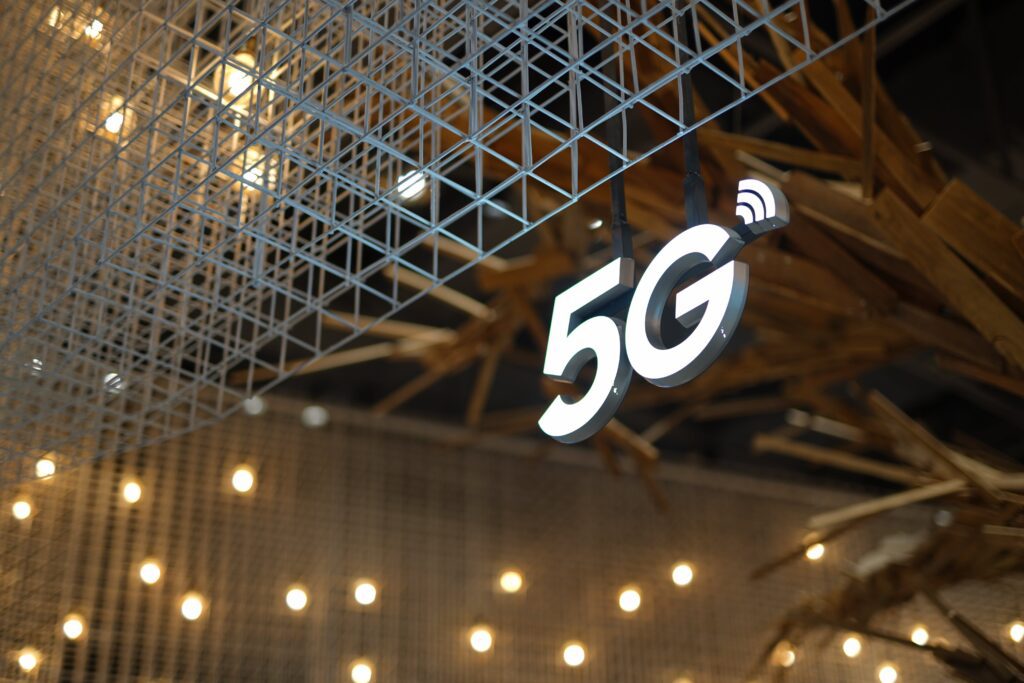As we stand on the precipice of a new digital era, the advent of 5G technology promises transformative change that reaches far beyond just faster download speeds. The fifth generation of cellular network technology, 5G, is an evolutionary leap from its predecessors, offering significant advances in speed, latency, and device connectivity. This innovative technology has the potential to reshape not only the telecom industry but also the way we interact with technology in our everyday lives, offering the possibility of ushering in new opportunities and challenges. This overview explores the innards of 5G technology, its standout features, its wide-ranging impact on IoT and smart devices, the obstacles in building a sturdy 5G infrastructure, and the intriguing real-world applications of this cutting-edge technology.
Understanding 5G Technology
5G Technology: The Next-Gen Revolution in Connectivity
Far surpassing the already impressive capabilities of its predecessor, 4G, fifth-generation technology, or 5G, is the high-speed, wireless connectivity that tech enthusiasts all over the world are raving about. This innovative technology caters to the demand for higher speeds, better performance, and robust connectivity in today’s digital landscape, which is being powered by an explosion of data.

5G technology isn’t a simple upgrade of wireless base stations. Rather, it is a completely reimagined network architecture, designed to meet the surging connectivity needs of today’s data-hungry devices and evolving technologies like IoT (Internet of Things), autonomous cars, and smart cities.
Unlike its predecessors, 5G uses a distinctive suite of new technologies. One of these technologies is millimeter-wave bands (24-100 GHz), a higher-frequency spectrum capable of transmitting massive amounts of data at an unbelievably high speed. But, these higher bands have a shorter range, which leads to another pivotal aspect of 5G’s design: a more densely packed network of smaller, lower-power base stations.
Of course, this change to a larger number of smaller stations entails more complex network management, so 5G also incorporates new technology: ‘network slicing’. This innovative addition allows for the creation of multiple virtual networks within a single 5G network, which is capable of providing connectivity at several different performance levels depending on a customer’s service level agreement (SLA).
Other game-changing technologies, like Massive MIMO (Multiple-Input, Multiple Output), also play a crucial role in 5G. MIMO uses multiple antennas at a single base station for simultaneous data streams, enhancing the capacity to serve more users.
Let’s not forget latency, or ‘lag’, in layman’s terms; 5G offers ultra-low latency compared to what 4G could offer. With 5G, lag times are expected to drop from 50 milliseconds to less than a millisecond. This kind of instantaneous response is crucial for technologies such as autonomous driving.
In terms of compatibility, 5G is designed to play nicely with existing networks. The deployment of 5G is expected to be a gradual process, where the new network builds on its existing 4G infrastructure.
One key takeaway? Speed. 5G offers speeds up to 100 times faster than 4G. That means sub-second download and upload times for HD movies and seamless, high-quality video calls.
In all, 5G technology showcases the potential that far surpasses being a mere extension of cellular connectivity. It will be the foundational technology for augmented reality, virtual reality, and artificial intelligence. And while these technological advancements may seem daunting, it’s important to keep in mind that technology is here to solve problems, not create them. The future painted by 5G is one brimming with possibilities and sectors will need to gear up to harness its full potential.
The Key Innovations in 5G Technology
Shifting from the revolutionary benefits of 5G, let’s delve deeper into what makes it technologically superior and more advanced than its predecessors. One of the most distinctive characteristics and a game-changer is the beamforming capability. Unlike 4G LTE which spreads signal in a wide radius, 5G uses beamforming to target a specific area with signal strength either from a single tower or multiple sources. This advanced method of data delivery boosts performance and efficiency by reducing interference and increasing capacity and speed.

Additionally, in 5G, we witness the advancement of networking with device-to-device (D2D) communications. With D2D, 5 G-enabled phones can interact with one another directly without relying on a network tower. This highly advanced feature is not just faster; it also consumes less power, avails more space on the network, and paves the way for a myriad of new applications such as enabling autonomous cars to interact with each other in real-time.
To meet the demands of expanded capacity and enhanced performance, edge computing perfectly complements 5G technology. By processing data closer to the source, edge computing reduces the distance information needs to travel, thereby decreasing latency and boosting the speed. Such a localized approach will immensely benefit real-time applications requiring high-speed responses.
The Internet of Things (IoT) also stands to reap significant benefits from 5G. The 5G network is designed to connect billions of devices simultaneously, an upgrade that will massively boost the development and utilization of IoT. The sheer volume of connections, enhanced speed, and lower latency will enable IoT devices to communicate and react in near real-time.
Simultaneously, 5G brings forth advanced network management in the form of network function virtualization (NFV) and software-defined networking (SDN). NFV and SDN decouple software from hardware, allowing sweeping flexibility in directing traffic and deploying resources, which in turn helps to optimize network performance. The infrastructure becomes less rigid and more adaptable, providing the flexibility to meet the challenges of tomorrow.
Lastly, the security enhancements in 5G are notable. With more data and devices connected, security becomes paramount. The advancements in quantum cryptography and encryption methods are evolving with 5G to protect the network and consumer data.
In essence, the move to 5G is not merely a leap in speed; it’s a total overhaul in the way wireless technology is used and perceived – an innovation that will revolutionize the entire digital ecosystem.
Implications of 5G on IoT and Smart Devices
5G: The Answer to the Future of IoT and Smart Devices
Stepping yet deeper into the realm of technology, the adoption of 5G is setting the foundation for a complete reengineering of IoT and smart devices. This seismic shift in connectivity is poised to redefine technology as we know it, unleashing unparalleled potential for innovation in every imaginable field.

Leveraging 5G is the key to unlocking the future of IoT. Let’s delve into how it will reshape the IoT terrain.
Seamless Communication for IoT Ecosystem:
5G’s beamforming capability sends radio waves in a tight beam directly to the user’s device rather than scattering them everywhere. This boosts network capacity by focusing the signal and diminishing interference, laying the foundation for robust, reliable connectivity. This becomes critical for IoT devices, which depend heavily on persistent, efficient communication pathways.
Realizing the promise of IoT:
Thanks to 5G’s device-to-device communications, it’s possible to have far greater device density – up to millions of devices per square kilometer. This connectivity improvement paves the way for an exponential rise in the number of IoT devices. Coupled with 5G’s ability to support a wider range of frequencies, even the smallest devices like sensors and trackers will be able to connect without draining power or eating up the spectrum.
Empowering Edge Computing:
Edge computing is an instrumental technology that works in conjunction with 5G to push computing power to the edges of the network. This is a big deal for IoT because it will significantly reduce latency, improving response times for IoT devices. Moreover, it will help to streamline the flow of traffic from IoT devices, making it easier to scale up IoT functionality in both consumer and commercial applications.
The Powerful Duo of NFV and SDN:
5G also brings network function virtualization (NFV) and software-defined networking (SDN) into the limelight. NFV enables the virtualization of network services, leading to agile networks that can adapt quickly to users’ needs. SDN, on the other hand, lends network operators unprecedented control over the flow of internet traffic. Together, NFV and SDN offer a degree of flexibility that can only translate into an even more personalized, potent experience for users right across the IoT spectrum.
Guaranteeing IoT Security:
5G networks raise the bar in security too, bringing quantum cryptography and advanced encryption methods to the forefront. IoT devices, already notorious for being hard to secure, will benefit enormously from these enhanced security measures, paving the way for a whole new era of increasingly interactive, and secure, smart technology.
Overall, the convergence of 5G technology and IoT will not just ensure that our lives become ultramodern and efficient, but it will also birth new opportunities for businesses and consumers alike. As we venture deeper into this technologically advanced era, the possibilities really do appear infinite. Welcome to the future, fueled by 5G. Let the era of smart living commence.
5G Infrastructure and Challenges
Understanding the Requirements for a Robust 5G Infrastructure
Given the sea of possibilities that the 5G revolution unfolds, it’s time we turn our attention to discussing the vital requirements needed for a robust 5G infrastructure.

High-Bandwidth Backhaul Capabilities
A key requirement for 5G is a proficient “backhaul” network. By this we mean the high-capacity network links that connect cell sites to the core network. As 5G promises exponentially higher data speeds, it’s essential to have a supporting infrastructure that can seamlessly handle this increased data volume. A highly effective fiber optic network is vital to support the backhaul and boost 5G performance.
Efficient Energy Use
5G networks require devices to be always active and ready to transmit data at unprecedented speeds. Hence, these devices could consume an enormous amount of energy. Therefore, a robust 5G network should prioritize energy efficiency, not only to reduce operational costs but also to meet environmental sustainability goals. This could be achieved through low-energy chipsets or network features such as “sleep modes” for low-traffic periods.
Robust Cybersecurity Measures
As the advanced 5G capabilities could be a double-edged sword, there is an increased vulnerability to cyber threats. Not to mention the fact that more connected devices in an IoT ecosystem broaden the playing field for prospective hackers. Consequently, implementing robust cybersecurity measures is paramount. The use of advanced authentications and encryptions should be inherent to the network to safeguard against data breaches.
Overcoming Obstacles to 5G Implementation
Despite the many benefits of 5G, there are certain challenges involved in its rollout.
Simultaneous Operations Across Different Spectrum Bands
While the use of millimeter-wave bands allows high-speed data transmission, they don’t have a vast range. Hence 5G networks would need to operate simultaneously across different spectrum bands – including those used by the existing 4G networks for comprehensive coverage.
Managing High Frequencies
5G also entails the challenge of managing higher frequencies. The higher the frequency, the more the amount of data a signal can carry but the lesser its range. Thus, implementing technologies that can manage these high frequencies while ensuring efficient coverage is a significant challenge.
Infrastructure Costs
The evolution from 4G to 5G requires a significant investment. This includes the costs associated with the installation of smaller, power-efficient base stations, equipping them with massive MIMO technologies for enhancing capacity, and other updates to the network architecture to support 5G services. Finding cost-effective solutions is crucial to resolving this hurdle.
Hence, the road to 5G supremacy may be strewn with challenges, but it’s a road worth taking. Once these hurdles are crossed, we’re looking at a future where delivering ultra-high-speed connectivity with minimal latency is not just possible – it’s the norm.
Real-World Applications of 5G
– Supercharging Remote Work and Education
The unprecedented situation over the last two years witnessed a dramatic rise in remote work and learning. 5G is poised to disrupt both segments significantly. With high data speeds, low latencies, and reliable connections, remote working can become seamless with quality video calls, increased cloud access efficiency, and more collaborative and immersive job training through AR/VR.
Moreover, education has a lot to gain from 5G. Digital classrooms can be more engaging through AR and VR technologies for simulated learning experiences. From virtual field trips to real-time translation services for international students, the possibilities are endless.
– Fostering Smart Cities
The role of 5G in developing smart cities cannot be overemphasized. Its capability to connect multiple devices in a dense urban area will drive Internet of Things (IoT) applications such as intelligent traffic systems, smart energy grids, connected public transportation, and more. The real-time data analysis capability of 5G will aid urban planners in making informed decisions, enhancing sustainability efforts, and improving the quality of life for city dwellers.

– Paving the Way for Autonomous Vehicles
5G is expected to be a game-changer in the realm of self-driving cars. The technology provides the necessary connection speeds and real-time data handling capabilities critical for autonomous vehicles. With 5G, vehicles will be capable of communicating with other cars, traffic systems, and nearby infrastructure, significantly improving safety and efficiency on the roads.
– Revolutionizing Healthcare
The healthcare sector awaits significant transformations with 5G technology. Remote patient monitoring, telemedicine, real-time imaging, and robotic surgery are some of the fantastic applications unlocked by 5G. The pandemic has handed us a glimpse of how telehealth can work, but it’s 5G that holds the key to its full potential.
– Unleashing Industrial IoT
5G can take Industry 4.0 or the fourth industrial revolution to the next level. The combination of 5G and IoT can supercharge various industrial operations ranging from predictive maintenance, real-time supply chain optimization, remote control of machinery, and more, contributing to an overall boost in productivity, efficiency, and safety.
Conclusion
5G is significant not merely for its speed or bandwidth – it’s about the transformative effects it can bring across sectors. While the journey to fully tap its potential may take a decade or more, the process is underway, and the glimpses are astounding. There’s a lot more to unearth regarding 5G applications as we collectively dip our toes into this uncharted territory. It indeed makes for no less than an exciting tech revolution, right within our grasp.
5G technology is not merely the next step in mobile telecommunication; it is a technological revolution that is poised to permeate various industries, from healthcare and manufacturing to transportation, showing itself as a true game-changer. As we look to the future, it is clear that the impact of 5G will be profound, reshaping the existing landscape of our society and paving the way for remarkable innovations. However, the successful implementation of 5G necessitates overcoming technical, regulatory, and societal challenges, which need coherent strategies and concerted efforts. As we inch closer to this exciting new realm of possibilities, it is essential to understand and prepare for the paradigm shifts that 5G will bring about, to ensure we harness its full potential for the betterment of humankind.

Hi, I’m Nathan Cross, a writer and avid reader who loves crafting articles for newspapers and online platforms. Words are my passion, whether I’m telling stories, sharing insights, or sparking conversations. When I’m not writing, you’ll find me lost in a book or out on the baseball field, enjoying the game that keeps me grounded. Writing, reading, and baseball—these are the things that define me.




